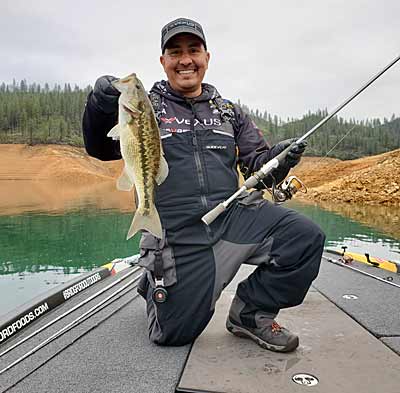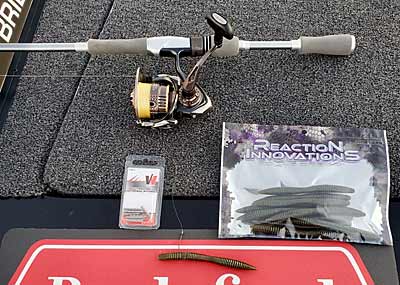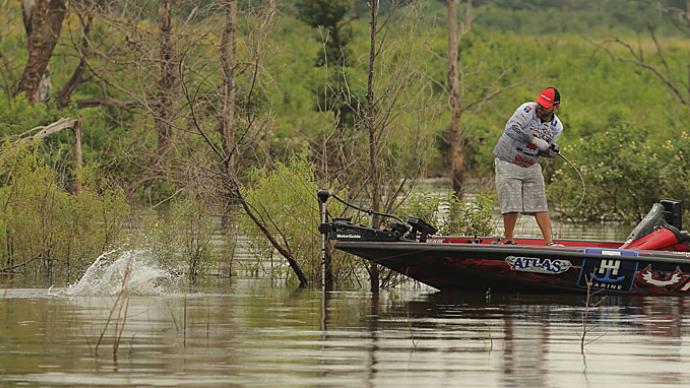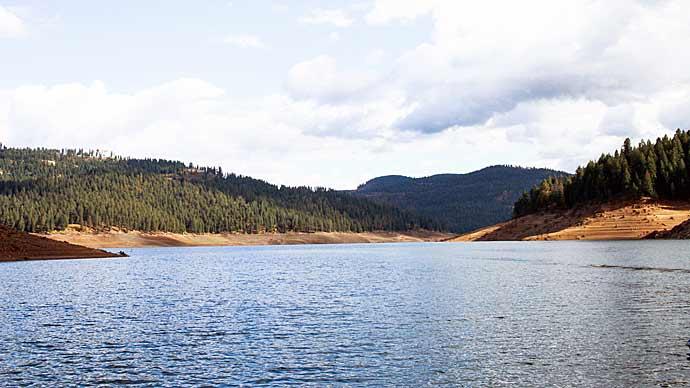
Pro bass fisherman Joe Uribe says that instead of starting his fishing career as a non-boater, he studied, evaluated, and analyzed all the tourneys for two years, then jumped in as a boater. It paid off – he cashed checks in his first and second tournaments, then won number three and took home a Ranger boat. He finished number two at his last tournament of the year at Mohave Lake, despite it being his first time there. Then FLW announced the National Guard Series in 2007, so he paired up with sponsor Unique Builders, and they cashed a check at Havasu and made the top ten in the series the first year.
There’s a new tournament series out west you may have heard of – the Apex Pro Tour. To fish the Apex Pro Tour, you must qualify through the four Wild West Bass Pro-Am tournaments: your best three out of four tournaments, based on AOY points, are counted. The top anglers are invited to fish Apex. There are no co-anglers in Apex – it’s pro on pro.
Each year, X invitations will be issued: this first year, there were 35. Your invitation allows you to fish for three years, but you need to re-qualify in year three. Tournament fishermen out west are stoked about this tour because there are camera crews everywhere, and the tournaments were televised on the Pursuit Channel starting this fall.
“The Apex Pro Tour gives western anglers a chance to give themselves and their sponsors national exposure,” says Apex qualifier Joe Uribe, “which is kind of a first out here, so everyone is excited about it.” He says he appreciates a chance to get this kind of exposure without going back east. He says many of the anglers work full time and can’t afford to travel across the country several times a year to compete.
The Apex tournaments have a different format. Each angler uses the TourneyX catch board and measures each fish. Every fish over fourteen inches counts, and each legal fish is submitted with a photo to track all the competitors live. You still keep your best five fish but release the rest. On day one, there is a split weigh-in – you weigh in around noon, then you go back out and can catch another limit before the second weigh-in. Day two is just one weigh-in. There are two ways to qualify for the final day – either by the total number of fish you caught on days one and two (top five totals) or by the total weight of the five big fish you brought to the weigh-ins (top five weights).
The anglers who qualify for day three start at zero, and the winner is the one with the most weight for his five biggest fish. This format forces you to make some choices, especially if you qualified with numbers instead of weight. At Camanche, Uribe qualified for day three with numbers, so he had to switch up since that last day, only your five biggest count. Versatility is vital, he says.
Tough Bass Fishing Conditions
With warm water and suspended bass, the fishing was tough at Camanche. Uribe says he figured out the bite at 10:00 am the first day. Changing water levels move the fish around, especially when the water is low, so he targeted ledges, channels, islands, etc. “When the water is stable, the fish are structure-oriented,” Uribe says, “but with it falling, the fish are messed up.” The lakes in California are shallow because of the drought, and many are closing because of low water levels – the water falls so far that there are no ramps.

Using his electronics was one of the keys to his success during the tournament. He’d locate fish in twenty to twenty-five feet on high spots such as off-shore humps, saddles, etc., near channels. At first, he sat over the fish, but he’d catch one, and the others would follow and disperse, so he changed tactics. Moving the boat about fifty feet away from the structure where he saw the fish, he’d use his Garmin LiveScope forward imaging to keep an eye on the fish in real time without spooking them.
He fished a Neko rig with a tungsten nail weight and a tube for the hook, so he didn’t tear up the bait every time he caught a fish. He rigs the worms with the hook point facing the bait's tail. The Neko, he says, is his go-to bait for tough fishing, mainly because in those conditions, most guys will be fishing a drop shot. He uses a Daiwa Tatula Seth Feider Signature Hair Jig/Neko rod, which is 7’6” with lots of backbone, but a soft tip to facilitate casting smaller weights. He pairs this with a Daiwa EXISTLT2500D-XH spinning reel filled with 20-pound-test Sunline PEx8 braid in Hi-Vis Yellow because he wants to be able to see the line. He attaches an 8- to 10-foot leader of 7-pound Sunline Shooter FC Sniper fluorocarbon line because of the clear, open water he was fishing.
His baits on those first two days included Zoom finesse worms in green pumpkin and a Reaction Innovations 4-1/2” Pocket Rocket in green with green pumpkin flakes. The tungsten nail weight he chose was just 5/64 because he wanted a slow, controlled fall. He could sit fifty feet away, cast his rig right over the fish, and let it work its way through them. “The coolest thing about this rig is that if you put it together the right way, it kind of glides as it falls. I call it the Death Spiral,” Uribe says. Most of the bites are on the initial fall, so make a cast, present the bait vertically, and keep the line slack by leaving the bail open. Shake it with the open bail, holding the rod at 45 degrees. The braid is very responsive, so the tail shakes, he says. If you feel a tic, a fish has it. You're on the bottom when it stops, and the line goes slack.
This takes a bit of practice, and Uribe suggests you practice it in a swimming pool where you can watch the bait. Watch the braid and practice shaking the rod as the bait falls. When the head with the nail weight hits bottom, the tail starts wagging. He gives it a couple of shakes at this point and then reels it back in for the next cast. With the open hook, you don’t have to use a massive hookset; reel into it. When you get the fish to the boat, the tube and the worm have slid up the line and are in perfect shape, so you can slide it back on the hook and keep fishing.
Wandering Bass
Changing water levels affect bass. Uribe knew that since the water was falling, the fish would move out, but when the water rises, they move up. When trying to figure out a pattern on the fly, you need to consider this. When a lake is filling, the fish start moving up, using creek channels from deep to shallow. They’ll set up on points – main lake points, then secondary points inside coves. It’s a process, he says, and it also depends on forage. The bass will follow the baitfish, so if the water comes up, but the baitfish don’t move up, the bass won’t move up either. In that case, they might still be out on deeper humps, and you can target them with a faster-moving bait like a small swimbait on a lead head jig.

Uribe says largemouth are wanderers and finds them more predictable than smallmouth bass. When fish are on the move, you need to use small swimbaits, cranks, and moving baits for suspended fish because, at that point, it’s all about timing. If the water has stayed low or high for a few days, the fish will be more predictable.
For those wandering bass, Uribe says he will throw several crankbaits that cover different depths to check all the levels, then keep throwing whatever works until they move again. The colder the water is, the less noise he wants his bait to make. Also, he uses more balsa wood cranks in colder water than plastic ones. Springtime is when he uses plastic cranks with rattles. He says that color plays a significant role and asks himself how the fish ate each bait. Did they eat it, or was it just a slap? If it’s just a slap, he will change color, slow down, or speed up. In dirty water, he chooses bright colors like chartreuse, and in clear water, he uses natural or transparent baits. Solid colors are more visible on overcast days, and he likes sunfish or bluegill colors with bright skies.
Crucial Advice
Uribe says that you must learn to rely on your electronics, including your graphs and your mapping software. These are the keys to following contours and staying on the fish. Learn to use the shading feature and how to change the contours to reflect the current lake level.
LiveScope was one of the keys to his success on Camanche, and it was especially crucial because, in the Apex tournaments, there are 30-day off limits. With no practice, locating fish electronically can mean the difference between being a hero or a zero. “Back in the day, you just had to make a ton of casts,” Uribe says, “but to compete these days, you need the best electronics, and you need to take the time to learn how to use them.”
BassResource may receive a portion of revenues if you make a purchase using a link above.




